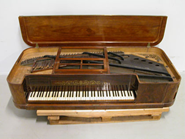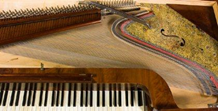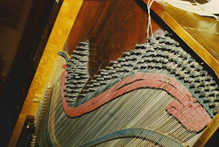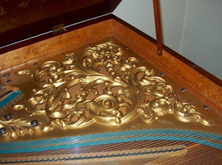A square piano is usually rectangular (table shape), although there are some variants that deviate from this. The rubenesque model appeared in Sweden around 1810 with rounded sides from the back, and with rounded side shapes from the keyboard round 1870. Squares have been around since the 18th century and have undergone a strong evolution from small and light instruments that are entirely made of wood, to the late-19th-century large and heavy constructions with heavy stringing and sturdy cast iron frames. During the 19th century, the table was the “standard piano” for a long time, but from about 1870 more and more gave way to the grand piano, as this developed rapidly. The last squares in Sweden were built around the turn of the century in 1900. Like all other pianos, the instruments followed the stylistic fashions of furniture.
In Swedish, we use a special term to denote the early squares, (without iron in their construction). These instruments may have hand stops for damping, knee pedals or different types of effect registers which later instruments lack. We call them “hammerklaver”, which is actually a collective term for all hammered instruments. This distinction is not used in International nomenclature. English has only “square piano”, and German only “Tafelklavier”. Older Swedish parlance from the 18th century and early 19th century used “piano forte” or “clavier”. The latter was also the common term for clavichords but which more and more came to denote early Square. “Fortepiano” then became the normal way to designate a square after the older keyboards disappeared. The modern Swedish language can create problems in describing transitional forms, where it can be difficult to decide how to classify an instrument that can have mixed forms between “hammerklavier” and “taffel”.





